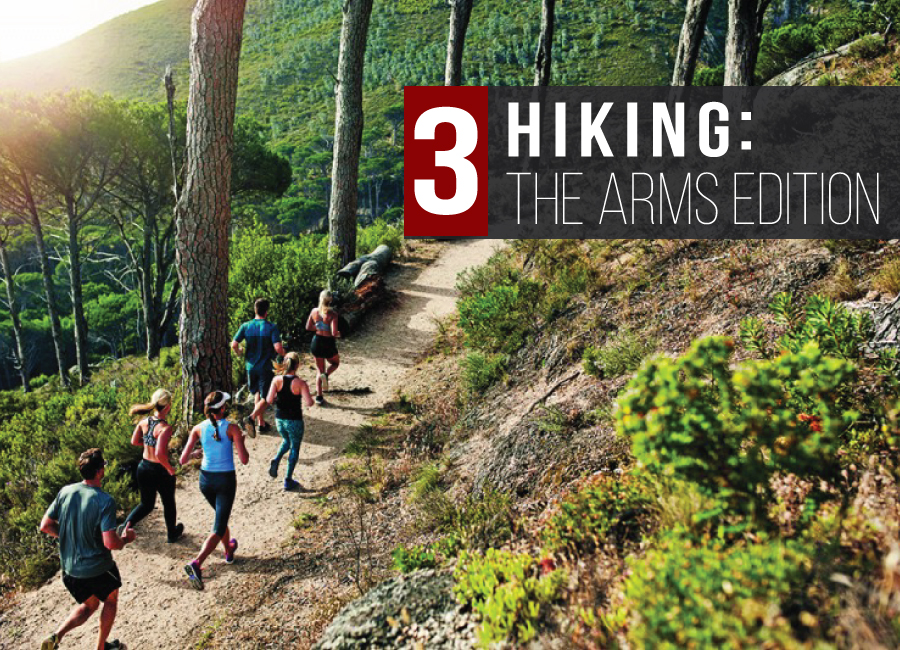Total Therapy Blog

Hiking 3. The Arms Edition
A lot of people don’t realize this, but your arms can make quite a difference during long and/or grueling hikes!
Series 3: The Arms Edition
Let’s put the trekking poles aside for now. I briefly talked about the role of arms in the previous series about trail running. As you’re probably well aware, we swing the arm opposite to the foot we’re stepping with. Why?
Well… To be honest, we don’t actually know exactly why.
 But! Have you ever tried walking with the same arm and leg, or not swinging your arms at all? It feels harder- or at the very least more awkward- and numerous experiments found that it costs more energy to walk this way. Whether or not this is because swinging your arms naturally helps with maintaining forward momentum, or because we just aren’t used to walking that way, studies have not yet come to a full conclusion. But at the very least, swinging your arms naturally will conserve energy that we can then save for the real hardworking heroes: our legs (and glutes!).
But! Have you ever tried walking with the same arm and leg, or not swinging your arms at all? It feels harder- or at the very least more awkward- and numerous experiments found that it costs more energy to walk this way. Whether or not this is because swinging your arms naturally helps with maintaining forward momentum, or because we just aren’t used to walking that way, studies have not yet come to a full conclusion. But at the very least, swinging your arms naturally will conserve energy that we can then save for the real hardworking heroes: our legs (and glutes!).
Maybe it’s postural?
Studies have shown that arms aid with trunk stability. Without our arms swinging by our sides, our core has to work extra hard! And then once our core muscles meet their endurance threshold, we’re left vulnerable to undue aches and pain. That being said, you don’t have to windmill your arms– still gotta conserve that energy!– only swing enough to counteract your legs.
Speaking of counteracting your legs…
 If action = reaction, which is not 100% true in this case but let’s loosely use it, then the more you swing your arm back, the more power you can achieve to swing your leg in front. Drive yourself forward with your arm swing. A good rhythm helps increase your speed without a large change in your perceived effort.
If action = reaction, which is not 100% true in this case but let’s loosely use it, then the more you swing your arm back, the more power you can achieve to swing your leg in front. Drive yourself forward with your arm swing. A good rhythm helps increase your speed without a large change in your perceived effort.
*Note: over-swinging your arms causes a larger backwards momentum, and the legs’ reaction to this is an increased tendency to heel-strike. Whether or not heel striking is earth-shatteringly terrible for you (as the current trend would like us to believe) is not the argument I’d like to get into right now, but if you are prone to pain in the area, it’s something to consider.
**Also worth mentioning that you should be driving your arms in a linear fashion. Deviating from the natural line of swing (whether you’re swinging too far inwards or outwards) distracts your legs as well, possibly increasing impact into your lower back, hips, IT band, knees, etc.
Uphill v.s. Downhill

Back in the trail running blogpost, I talked about how bent elbows create a lighter arm swing, which is ideal for flats or uphill. As a rule of thumb, I try to maintain the same angle of steepness with my elbows; the steeper the uphill, the more bent my elbows are.
Speed is great when you want it but it’s also taxing for the legs, especially during downhill because of the eccentric nature. Help your legs out by “braking” with your arms. Keep them extended and, rather than slicing through the air, imagine you’re dragging them to slow down your momentum.
While admittedly some of these tips are derived from running techniques, I don’t see any harm in applying it to hiking. Save your legs, add some arm movement, and voila: a full(er) body workout. Give me a big windmill high-five if you see me out in the forest to show me your arm awareness!
Happy trails,








Follow Us!
& Stay Up To Date
BLOG